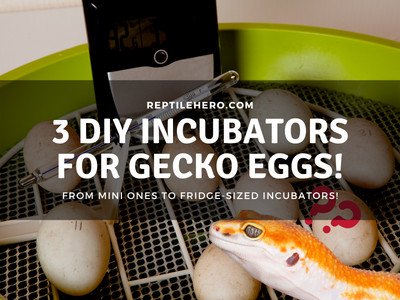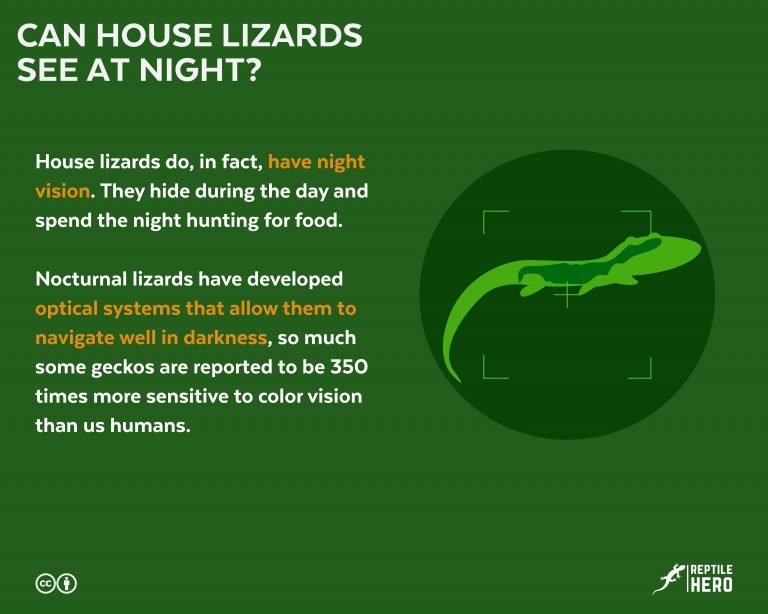Homemade Crested Gecko Food [10 Recipes]
Are you thinking of adding a little bit of variety to your crested gecko’s bland premix powder meals and occasional dusted insects? Fresh fruits might be one of the available food choices that have struck your mind. In what ways can you give them to your gecko? And should you?
Crested geckos are omnivores, so they can eat plants and other animals. The staple foods for crested geckos are diet premixes and insects. Many fruits can be safely given in the form of smoothie treats once a week. However, fruits with Vitamin C, oxalic acid, and persin should be avoided.
Check out these easy-to-prepare recipes for your gecko!
What Do Crested Geckos Eat?
You might be confident (and it is true) that captive crested geckos can survive eating primarily commercial Crested Gecko Diets (CGDs) premixes their whole life. However, you might be interested and have wondered, “What do the wild ones have in the forests?”
In a field study, the stomach contents of an appreciable number of Correlophus ciliatus were analyzed over some time [1]. The research revealed that crested geckos eat a large variety of food such as berries and small animals with a predominance (more than 70%) of insects.
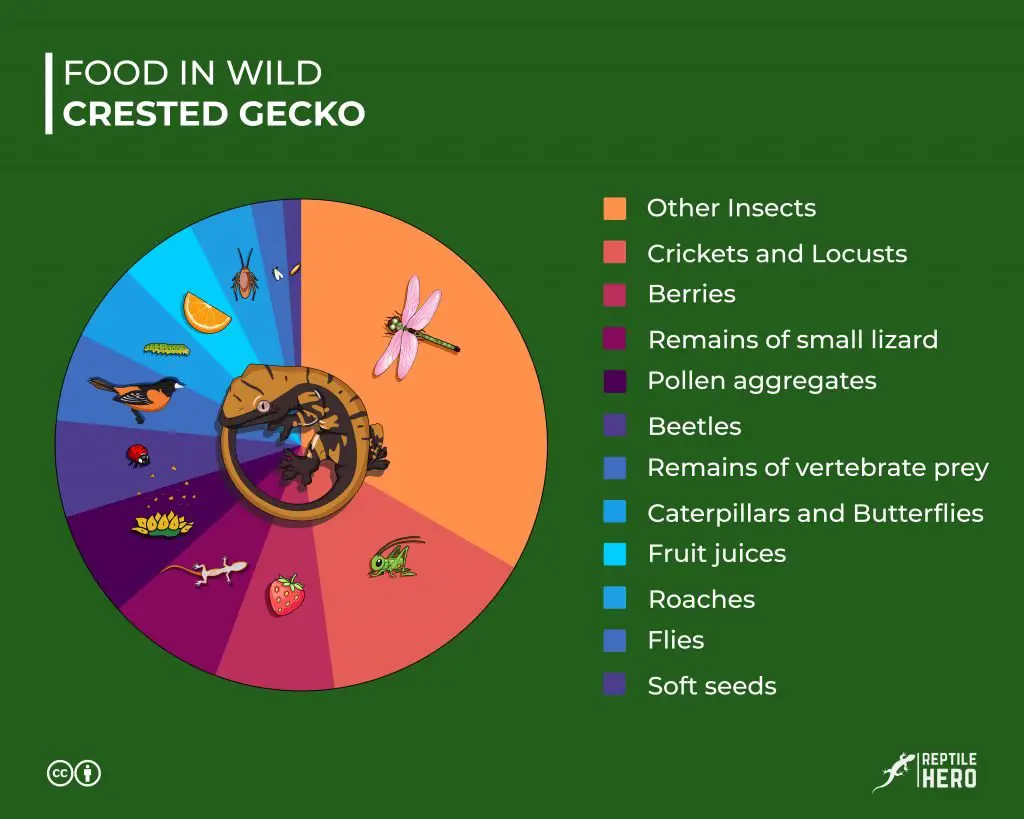
| Stomach Content | Proportion, % |
| Other Insects | 49.60 |
| Insects like locusts and crickets | 21.60 |
| Plant matter such as berries | 11.70 |
| Vertebrate prey including carcasses of small lizards | 11.40 |
| Plant matter including pollen aggregates | 10.30 |
| Insects like beetles | 9.45 |
| Vertebrate prey including carcasses of smaller animals | 8.68 |
| Insects like butterflies and caterpillars | 7.52 |
| Plant matter like fruit juices | 7.52 |
| Insects like roaches | 6.20 |
| Insects like flies | 3.12 |
| Plant matter like soft seeds | 1.80 |
The result may surprise you—like how it did to most of us—because insects compose most of their diet! But this is not supposed to cause you concern since crested geckos are omnivores. And they can casually devour insects like in the video below.
What is available in the wild is ever-changing. So, nutritional contents are prone to variations. And wild geckos are subject to health issues.
With the staple CGDs that are commercially available to us, we are sure to provide the most complete dietary requirements our small reptiles need. However, it does not hurt your gecko to have some occasional treats like fresh fruits!
What Are Fruits Safe For Crested Geckos?
Some of the many fruits that are safe for crested geckos are:
- Apricot
- Banana
- Blackberry
- Blueberry
- Dates
- Figs
- Grapes
- Mango
- Papaya
- Peach
- Pear
- Plum
- Raspberry
- Strawberry
- Watermelon
While a considerable portion of their diet in nature mainly consists of insects, crested geckos still benefit from fruits. So, it should be excellent to include different plant matters (although not as a significant chunk) in your gecko’s diet.
Most of the fruits in the list above are often part of my recipes. But you can mix and match different fruits with unlimited combinations to your liking. And see how it goes for your geckos.
What Fruits Should Crested Gecko Avoid?
Crested geckos should avoid 1) fruits with Vitamin C, 2) fruits with oxalic acid, and 3) fruit with persin as they may be toxic.
The list of safe fruits you can feed your crested geckos goes on and on. So, you might think that you can use any and every fruit to blend up for your smoothie treat. But always be careful with these three groups of unsafe fruits.
1. Fruits with Vitamin C
As it is often cited by many crested gecko owners, avoiding fruits with high concentrations of Vitamin C in crested geckos’ diet has become empirical knowledge. Pieces of anecdotal evidence show that these fruits cause diarrhea, resulting in dehydration.
Although not restricted to them, citrus fruits are generally popular to contain high levels of Vitamin C. To name, some typical citrus (and non-citrus) fruits are:
- grapefruits
- kiwis
- lemons
- limes
- oranges
- pineapples
- tangerines
2. Fruits with Oxalic Acid
Green leafy vegetables—like beets, rhubarb, and spinach—are infamous for high concentrations of oxalic acid. But fruits—especially citrus and star fruit—are known to contain significant levels as well.
In research conducted on green iguanas, fruits and vegetables rich in oxalic acid have shown adverse effects on the lizard [2]. The study has revealed that:
- Oxalic acid (as oxalates) inhibits calcium absorption of the body by binding to the mineral.
- This reaction depletes available calcium for the body to use, resulting in hypocalcemia.
While you are unlikely to feed your gecko with vegetables, you might want to take note of avoiding citrus and star fruit because of their hazards.
3. Fruit with Persin
If you have cats and dogs, you might be aware to never feed them with anything that has avocado. Do you know why?
The flesh of avocado fruit contains a low concentration of persin, a fungicidal toxin. This concentration is generally harmless to humans. However, the same amount is already dangerous to small animals like cats and dogs. [3]
Fortunately, most of the persin is saturated in the leaves, fruit skin, and fruit shells. But exactly what amount of this chemical is lethal to different animals is not yet known.
With its dangers to bigger pets like cats and dogs, it is imperative that the fruit could cause the same (or even worse) health problems to reptiles, such as crested geckos. So, for this reason, you should also avoid it.
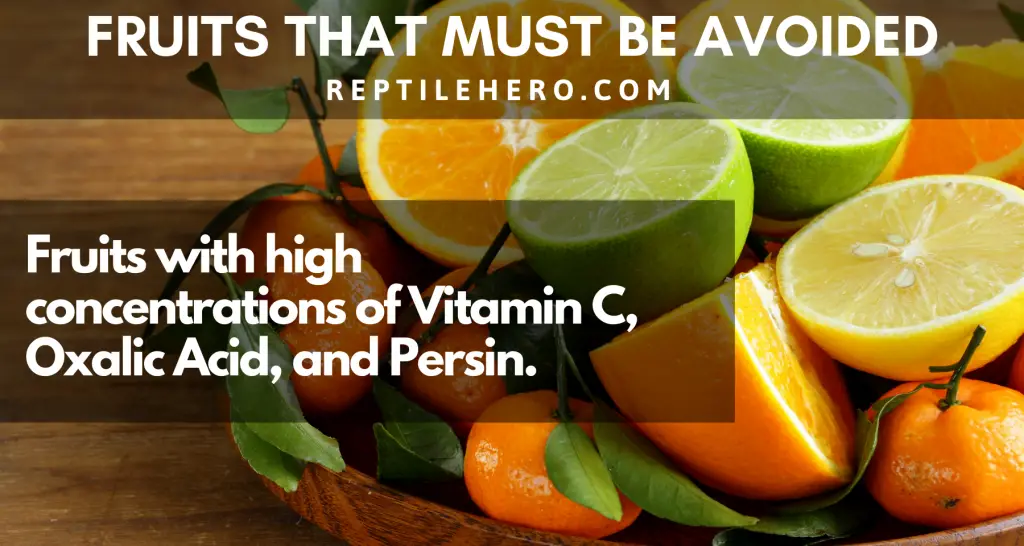
10 Homemade Smoothie Treat Recipes For Cresties
Just to remind you. There are no D.I.Y. or homemade food alternatives to replace good staple CGDs. As a result, take these recipes as food treats that you can only give and feed your geckos moderately.
As a food treat, homemade smoothie recipes do not take into account nutritional values. To begin with, your geckos should not be eating these treats.
So, choosing the healthiest fruit does not have great importance. Instead, how much (must only fill a small dish bowl) and how frequent (at most once a week only) are the questions you have to think about.
So, you may disregard memorizing the list of fruits with the most amount of calcium or fruits with the least amount of phosphorus. Instead, you can just take note of the fruits you need to avoid as ingredients to your customized smoothie treats.
Here are 10 recipes you might want to consider as your basis when making your own.
#1 Smoothie Recipe
Ingredients:
- 1 pear
- 1 mango
- 1 banana
- 1 papaya
- 2 to 3 dried figs
- 1 can of peach juice (not syrup)
- ½ cup of natural, plain yogurt with no sugars or artificial sweeteners
Directions:
- Peel off the banana skin.
- Add the whole banana to the blender.
- Slice the dried figs, papaya, mango, and pear into cubes.
- Add the cubed fruits to the blender.
- Blend the fresh fruits.
- Pour the peach juice.
- Add the yogurt to the blender.
- Whizz everything in the blender.
- For feeding:
- Scoop out enough smoothie to the dish bowl.
- Add any proper supplements.
- Mix lightly with the spoon.
- For storage:
- Store leftovers in ice cube trays.
- Freeze inside a Ziploc bag.
#2 Smoothie Recipe
Ingredients:
- 1 banana
- 1 mango
- 1 peach
- 1 cup of unsweetened plain yogurt
Directions:
- Peel off the fruits.
- Slice the peeled fruits into cubes.
- Place the sliced fruits in three different cups.
- Scoop out a cup of yogurt.
- Throw each cup of fruit into the blender.
- Blend all the fruits together.
- Add in the yogurt in the blended fruits.
- Blend all the ingredients together.
- Put the smoothie in the food dish.
- Feed immediately.
#3 Smoothie Recipe
Ingredients:
- 1 mango
- 1 banana
- 1 tsp of Calci-Dust
Directions:
- Peel off the mango skin first.
- Slice a portion of the mango.
- Set aside the thin sheets of mango for later.
- Skin off the large banana.
- Take only half of it.
- Smush it using a fork.
- Mix the mashed banana and sliced mango in a bowl.
- Sprinkle the Calci-Dus into the mixture.
- Mix the mixture until it becomes a mushy paste.
- Load it into the dish bowl.
- Feed immediately.
#4 Smoothie Recipe
Ingredients:
- 1 pear
- 3 apricots
- 1 cup of mango
- 1 medium papaya
- 1 cup of strawberries
- ½ cup of unsweetened plain yogurt
- 1 cup of peaches in juice (not syrup)
Directions:
- Cut and pit all of the fruits.
- Skin the papaya out before cutting.
- Take out all of the papaya’s seeds.
- Put all the fruits in the blender.
- Blend the fruits together.
- Add the yogurt to the mixture.
- For storage of up to 3 months in the freezer:
- Portion out the mixture in an ice cube tray.
- Freeze inside a Ziploc bag.
- For feeding:
- Defrost one cubed mixture.
- Add any supplements before feeding.
#5 Smoothie Recipe
Ingredients:
- 1 pear
- 1 mango
- 1 banana
- ¼ cup of water
- 1 tbsp of organic honey
- ¼ tsp of Repashy Calcium Plus
Directions:
- Peel off the banana skin.
- Add the whole banana to the blender.
- Peel the pear and mango.
- Slice the two fruits in half.
- Chop into cubes.
- Toss the pear and mango cubes into the blender.
- Pour in the water.
- Add the organic honey.
- Dust off the Repashy Calcium Plus.
- Blend the mixture.
- For storage of up to 9 months in the freezer:
- Pour the smoothie onto an ice cube tray.
- Place the ice cube tray inside a Ziploc bag.
- For feeding:
- Thaw out 2 to 3 cubed treats into the dish bowl inside the tank.
#6 Smoothie Recipe
Ingredients:
- 8 grapes
- 1 banana
- 7 raspberries
- ¼ cup of water
- 1 tbsp of organic honey
- ¼ tsp of Repashy Calcium Plus
Directions:
- Peel off the banana skin.
- Add the whole banana to the blender.
- Toss the grapes and raspberries into the blender.
- Add the organic honey into the blender.
- Dust off the Repashy Calcium Plus.
- Pour in the water.
- Start and blend everything together.
- For storage of up to 9 months in the freezer:
- Pour the smoothie onto an ice cube tray.
- Place the ice cube tray inside a Ziploc bag.
- For feeding:
- Thaw out 2 to 3 cubed treats into the dish bowl inside the tank.
#7 Smoothie Recipe
Ingredients:
- 1 banana
- 6 strawberries
- ¼ cup of water
- 1 tbsp of organic honey
- A handful of blueberries
- ¼ tsp of Repashy Calcium Plus
Directions:
- Peel off the banana skin.
- Add the whole banana to the blender.
- Take the blueberries into the blender.
- Slice off the leaf portion of the strawberries.
- Toss these strawberries into the blender.
- Add the organic honey.
- Scoop out Repashy Calcium Plus.
- Pour in the water.
- Blend everything together.
- For storage of up to 9 months in the freezer:
- Pour the smoothie onto an ice cube tray.
- Place the ice cube tray inside a Ziploc bag.
- For feeding:
- Thaw out 2 to 3 cubed treats into the dish bowl inside the tank.
#8 Smoothie Recipe
Ingredients:
- 3 to 4 figs
- 1 to 2 soft pears
- 1 or 2 other fruits in season
- 1 small to medium ripe banana
- 1 large can (approx. 800 g) of unsweetened mango pulp
- 1 can of low fat, unsweetened yogurt (strawberry, mixed berries, or peach)
Directions:
- Put the figs, pears, banana, and other fruits in the blender.
- Blend until smooth.
- Add the mango pulp to the blend.
- Mix lightly with a spoon.
- Pour the pureed fruits into a mixing bowl.
- Add the yogurt.
- Mix thoroughly.
- For storage:
- Scoop the smoothie into ice cube trays.
- Freeze inside a Ziploc bag.
- For feeding:
- Thaw out 1 to 2 ice cubes.
- Put them in the dish bowls.
#9 Smoothie Recipe
Ingredients:
- 1 banana
- 1 mango
- 8 strawberries
- ¼ cup of apple juice
- ½ container of no sugar, low-fat raspberry yogurt
Directions:
- Put the banana, mango, and strawberries in the blender.
- Pour the apple juice into the blender.
- Add the yogurt.
- Blend until smooth.
- For storage:
- Scoop the smoothie into ice cube trays.
- Freeze inside a Ziploc bag.
- For feeding:
- Thaw out 1 to 2 ice cubes.
- Put them in the dish bowls.
#10 Smoothie Recipe
Ingredients:
- 2 pears
- 2 white peaches
- 45 skinned grapes
- 1 small jar of peach baby food
- ½ container of no sugar, low-fat raspberry yogurt
Directions:
- Put the pears, white peaches, and grapes in the blender.
- Scoop out the yogurt to the blender.
- Add the jar of baby food.
- Blend everything until smooth.
- For storage:
- Scoop the smoothie into ice cube trays.
- Freeze inside a Ziploc bag.
- For feeding:
- Thaw out 1 to 2 ice cubes.
- Put them in the dish bowls.
Do D.I.Y. Treats Have Benefits?
Like any fresh fruit recipes online, these recipes are not meant to replace the crested gecko staple food—CGDs and insects. This trusted commercial food ensures you have met your gecko’s nutritional needs.
Since fruits and berries change seasonally, there is no guarantee of their exact nutritional content. What is known to be always true is their high sugar content. As a result, you cannot rely entirely on these alone.
So, the only legitimate benefactor of giving D.I.Y. treats is you. By doing what you like to do with your pet, you make yourself feel good. And that is entirely okay. I understand because I am like that too. As long as it does not harm your pet, then you can continue with what you do.
Are There D.I.Y. Food Recipes For Leopard Geckos?
If you also have a leopard gecko, you might be wondering what homemade fresh fruit recipes to give it as a treat. Unfortunately, there are none.
Leopard geckos are carnivores—specifically insectivores. This means that no fruits, vegetables, and other plant matters would be eaten and digested. So, their diet entirely consists of live insects and other smaller prey.
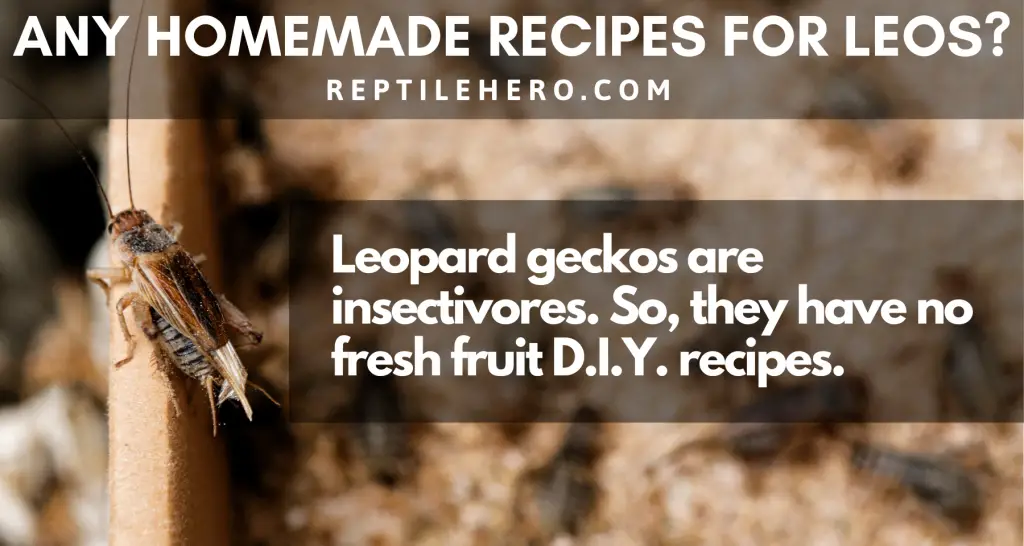
Takeaways:
Crested geckos are best fed with commercially available and trusted CGDs. Not only are these easy to purchase, but they are also complete with the nutrients they need daily.
Knowing that they are omnivores, crested geckos can be safely fed with fruits in the form of smoothies. Different recipes of smoothies are easy to do with available ingredients in the kitchen.
While there is a long list of safe fruits for their consumption, there is a shorter list of fruits that must be avoided at all costs. These are fruits with vitamin c, oxalic acid, and persin.
Even though fresh fruits are seen as healthy, they can have high sugar content and inconsistent nutritional content. So, they are best served as treats.
Homemade fresh fruit smoothies should be considered as treats. So, they must be given sparingly—at most once a month—in amounts enough to fill the dish bowl.
Sources:
[2] https://www.caza-narg.ca/ref/ref200806-2.pdf
[3] https://www.aspca.org/pet-care/animal-poison-control/toxic-and-non-toxic-plants/avocado

![Why is Your Leopard Gecko’s Nose Red? [9 Causes and Solutions]](https://www.reptilehero.com/wp-content/uploads/2021/10/Red-nose-gecko-cc-768x614.jpg)
![The 5 Reasons Why Do Your Geckos Jump [and 5 Precautions]](https://www.reptilehero.com/wp-content/uploads/2022/01/why-geckos-jump-cc-768x614.jpg)
